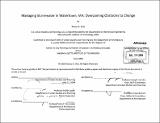| dc.contributor.advisor | Judith Layzer and John E. Fernandez. | en_US |
| dc.contributor.author | Chai, Shutsu K. (Shutsu Kindness) | en_US |
| dc.contributor.other | Massachusetts Institute of Technology. Dept. of Architecture. | en_US |
| dc.coverage.spatial | n-us-ma | en_US |
| dc.date.accessioned | 2010-03-25T15:17:25Z | |
| dc.date.available | 2010-03-25T15:17:25Z | |
| dc.date.copyright | 2009 | en_US |
| dc.date.issued | 2009 | en_US |
| dc.identifier.uri | http://hdl.handle.net/1721.1/53225 | |
| dc.description | Thesis (M.C.P.)--Massachusetts Institute of Technology, Dept. of Urban Studies and Planning, 2009. | en_US |
| dc.description | Includes bibliographical references (p. 65-68). | en_US |
| dc.description.abstract | As effective imperviousness increases with urbanization, the impacts of stormwater runoff on local water systems and aquatic life are more and more deleterious. Stormwater runoff carries pollutants into nearby water bodies, alters stream banks, reduces stream base flows and bypasses infiltration processes that both clean and recharge groundwater. While these consequences are still invisible to the average citizen, human life is wholly dependent on adequate quantity and quality of water resources, which polluted stormwater runoff threatens. This link has motivated more widespread attention to and effort in stormwater management, yielding new technologies, initiatives and solutions. As this new paradigm for stormwater management grows better established and more broadly accepted, the struggles to minimize the impact of runoff have shifted from the technology to implementation. A deeper understanding of the challenges and barriers to the adoption of new best management practices will allow us to better target efforts to overcome those obstacles. Conducting a case study of Watertown, MA, I interviewed local officials, planners and activists. Through these conversations, I identified four primary barriers: funding shortages, disagreement over implementation mechanisms, knowledge limitations and site constraints. Despite these limitations, educational programs, codified local regulations coupled with design guidelines and a flexible local funding source can help localities surmount those hurdles. | en_US |
| dc.description.statementofresponsibility | by Shutsu K. Chai. | en_US |
| dc.format.extent | 68 p. | en_US |
| dc.language.iso | eng | en_US |
| dc.publisher | Massachusetts Institute of Technology | en_US |
| dc.rights | M.I.T. theses are protected by
copyright. They may be viewed from this source for any purpose, but
reproduction or distribution in any format is prohibited without written
permission. See provided URL for inquiries about permission. | en_US |
| dc.rights.uri | http://dspace.mit.edu/handle/1721.1/7582 | en_US |
| dc.subject | Urban Studies and Planning. | en_US |
| dc.subject | Architecture. | en_US |
| dc.title | Managing stormwater in Watertown, MA : overcoming obstacles to change | en_US |
| dc.type | Thesis | en_US |
| dc.description.degree | M.C.P. | en_US |
| dc.contributor.department | Massachusetts Institute of Technology. Department of Urban Studies and Planning | |
| dc.identifier.oclc | 530218545 | en_US |
